Abstract
Król, H and Gołaś, A. Effect of barbell weight on the structure of the flat bench press. J Strength Cond Res 31(5): 1321–1337, 2017—In this study, we have used the multimodular measuring system SMART. The system consisted of 6 infrared cameras and a wireless module to measure muscle bioelectric activity. In addition, the path of the barbell was measured with a special device called the pantograph. Our study concerns the change in the structure of the flat bench press when the weight of the barbell is increased. The research on the bench press technique included both the causes of the motion: the internal structure of the movement and the external kinematic structure showing the effects of the motion, i.e., all the characteristics of the movement. Twenty healthy, male recreational weight trainers with at least 1 year of lifting experience (the mean ± SD = 3.3 ± 1.6 years) were recruited for this study. The subjects had a mean body mass of 80.2 ± 8.6 kg, an average height of 1.77 ± 0.08 m, and their average age was 24.7 ± 0.9 years. In the measuring session, the participants performed consecutive sets of a single repetition of bench pressing with an increasing load (about 70, 80, 90, and 100% of their 1 repetition maximum [1RM]). The results showed a significant change in the phase structure of the bench press, as the barbell weight was increased. While doing the bench press at a 100% 1RM load, the pectoralis major changes from being the prime mover to being the supportive prime mover. At the same time, the role of the prime mover is taken on by the deltoideus anterior. The triceps brachii, in particular, clearly shows a greater involvement.
Key Words: movement features, movement analysis, SMART measuring system
Introduction
Among recreational and performance athletes, bench pressing is one of the most popular weight-training exercises. Bench press exercises are often prescribed for developing hypertrophy and general strength in the upper muscles engaged in pressing. Bench press exercises are also meant as a method of testing and predicting performance. Although there are many publications dealing with the subject of the bench press (5–7,18,24,28), there are few data describing how the kinematics of a lift and the upper limb myoelectric activity change when there is an increase in the weight of the barbell (4,15).
In quantitative biomechanical motion analysis, the temporal characteristics of the mechanical parameters are mainly used. In analyzing the underlying mechanisms of the sticking region in the bench press movement of a representative subject, Elliott et al. (4) reported alterations in the barbell path, force profile, and myoelectric signals of bench presses performed at differing loads. Santana et al. (25) presented a time history of normalized electromyographic (EMG) amplitudes and trunk kinematics for 1 repetition maximum (1RM) traditional bench press and a standing cable press, of a random subject, to better understand the biomechanical limitations of pushing. Drinkwater et al. (2), on the other hand, employed an optical encoder to determine the power changes during the initial acceleration and sticking region throughout fatiguing repeated bench press training. However, there is still no work covering a comprehensive quantitative analysis of the bench press. There is also a need for generalizations, which are carried out by averaging the temporal characteristics of the movement.
Research on the bench press technique should cover both the causes of the motion (the internal and external kinetic structure of the movement—all the characteristics of the movement; Figure 1) and the external kinematic structure of the movement that shows the effects of the motion. The structure of the movement is most informative, and being very readable it is useful in the evaluation of sport techniques. Equally important are the other “movement features,” for example: the rhythm, the accuracy, and the fluidity of the movement (26). What is only available to the observer, although, is the spatiotemporal structure of the movement. The assessment of the spatiotemporal structure and the other categories of description when based only on visual observation is relatively simple but provides little information. Therefore, in the past, a complex methodology of investigations was used to investigate the movement structure in weightlifting and powerlifting (Ref. 14,15; respectively).
Figure 1.
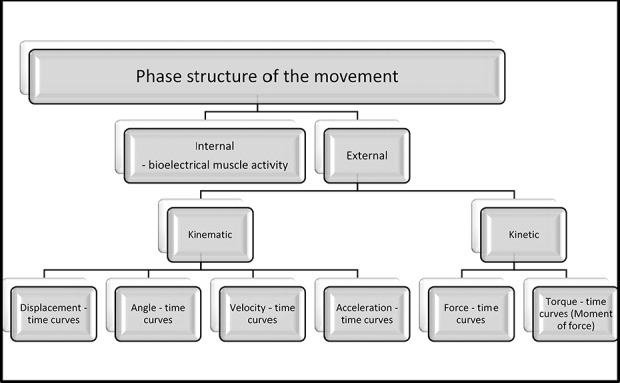
The classification of the phase movement structure—all the characteristics of the movement.
In this study, we have used the multimodular measuring system (SMART-E; BTS Company, Milan, Italy) and a special device to track the position of the barbell (pantograph [the comparison of the parameters registered with the SMART system and with the pantograph showed that the results obtained were in agreement (15)]), while studying the changes in the structure of the flat bench press when the weight of the barbell is increased. Sometimes, just small differences that cannot be noticed at first sight may strongly influence the performance of certain sport skills. Although many variables influence success in a sport, including psychological and physiological factors, biomechanical considerations as reflected in correct or incorrect techniques are crucial for the athletes. A better understanding of the bioelectrical activity in the primary muscles in the free barbell bench press could aid in load selection among lifters who may be experiencing slowed progress or plateaus in their strength training programs.
Taking into consideration the existing information and the lack of information, the first aim of this study was to investigate the internal and external structures of the flat bench press. The second aim was to investigate the relationships that characterize these structures, according to the bench press load. Based on previous studies (12,13,15,23), we hypothesized that the subjects' muscle EMG amplitude levels would be higher and the velocity and acceleration values of the barbell would be smaller as the load is increased.
Methods
Experimental Approach to the Problem
To examine the primary hypothesis of the present investigation, subjects performed flat bench presses, and increasing loads were added during each lift. To evaluate the internal structure of this movement (the activity level of the 4 shoulder muscles), EMG activity was monitored using surface electrodes placed where there was motor activation of the muscles during each lift (19). The electromyography signals processed with the integrals of the linear envelope (IEMG; integration after the present time—0.1 seconds) algorithm were calculated over the descent and ascent phases for each muscle during each trial. The signals were normalized by an isometric reference position (IRP) (16). To evaluate the external kinematic structure of the flat bench press (displacement and velocity and acceleration–time curves of the barbell), the hand and barbell movements were recorded by 6 infrared cameras. An analysis of variance (ANOVA) was performed to test the hypothesis mentioned in the Introduction.
Subjects
Twenty healthy, male recreational weight trainers with at least 1 year of lifting experience (the mean ± SD = 3.3 ± 1.6 years) were recruited for this study. Demographic data of the subjects are given in Table 1. The research project was approved by the Committee of Bioethics of the Jerzy Kukuczka Academy of Physical Education in Katowice, Poland. Each participant signed an informed consent form before the beginning of the study. No subject had any history of injury or illness that might affect lifting performance. The participants had been involved in regular resistance training, 2–5 days a week for the preceding 6 months, on barbell flat bench presses. The participants had not performed any arm exercises for a minimum of 24 hours before the test.
Table 1.
Demographic data of the subjects (N = 20).*

Testing Procedure
The protocol included a flat bench press with free weights and the “touch-and-go” technique. The research information for the study was collected during the warm-up and the main session. After a general warm-up (a 10-minute run on the treadmill and stretching), all participants performed a more specific warm-up that consisted of 3 sets of 10 to 5 repetitions with light weights selected by the subjects (at 40/60% 1RM of the flat bench press). In the main session, the participants performed consecutive sets of a single repetition of flat bench pressing, and each time with increased loads (70, 80, 90, and 100% 1RM the anticipated maximum weight), until the appointment of one maximum repetition. When a participant reached the anticipated maximum weight, the load was increased until the participant could no longer perform a correct flat bench press. Those who registered attempts that constituted approximately 70, 80, 90, and 100% of 1RM were chosen for analysis (Table 1). If the previous loads did not encompass these values, the participant would perform a flat bench press with the missing load after the maximum attempt. In total, each participant performed between 6 and 9 attempts in the main session. The rest periods between the trials lasted about 5 minutes and were provided to avoid muscular fatigue. For the flat bench press, subjects were in a supine position with the head and trunk supported by the bench, the knees bent, and the feet flat on the floor. All participants used a grip that was 81-cm wide between the forefingers, in accordance with the International Powerlifting Federation's special requirements. One or 2 research assistants acted as the spotter(s) standing behind or near the bench in the event that the participants were not able to successfully lift the weight. The spotter assisted the man in lifting the bar from a support rack, but the weightlifter was not assisted by the spotter during the lift. The barbell was lowered in a smooth, controlled manner to touch the chest (with no “bouncing”) before being returned to a full arm extension (with no excessive arching of the back).
Instrumentation and Data Collection
A multidimensional movement analysis was made with the measuring system Smart-E (BTS). The system consisted of 6 infrared cameras (120 Hz) and a wireless module to measure muscle bioelectric activity (Pocket EMG; BTS Company, Milan, Italy). In addition, as already mentioned, the path of the barbell was measured with the pantograph.
Three-Dimensional Kinematics
A set of passive markers reflected the infrared radiation (IR), permitting the calculation of some chosen motion parameters of the barbell, and the subject's arms. Large spatial accuracy was achieved by attaching the test passive markers in the axis of rotation of the upper limb joints of the subjects, and in the center and at the ends of the barbell. The technical accuracy of the system after the calibration process was 0.4 mm, which was the accuracy of measurement, i.e., the distance between 2 markers in 3D. Based on the deterministic registered trajectory of the barbell after smoothing (the trajectory was processed with the weighted average algorithm), the characteristics of velocity and acceleration of the barbell were also calculated and smoothed. Modelings in 3D space and the calculations of the parameters were performed with Smart software (Smart Capture, Smart Tracker and Smart Analyzer; BTS).
Electromyography
The participant's skin where the mounting disposable surface electrodes (1 cm2, silver–silver chloride) were to be located was specially prepared by lightly sanding the skin with an abrasive paste and then cleaning the skin with alcohol. The electrodes were placed parallel to the direction of the muscle fibers of the sternocostal head of the pectoralis major (PM), the deltoideus anterior (DA), the long head of the triceps brachii (TB), and the latissimus dorsi (LD) muscle, in accordance with the European Recommendations for Surface Electromyography (SENIAM) (10). All electrodes remained in place until the data were collected in 4 tasks and the normalization was carried out.
The EMG signals from each trial were sampled at a rate of 1 kHz and measured by a Pocket EMG System (BTS). The analog signals were filtered (passband Chebyschew filter, 10–500 Hz) and converted to digital with 16-bit sampling resolution and collected on the measure unit. All active channels were the same, and the measuring range was fitted to the subject (typically ±10 mV). After being captured, the signals were transmitted immediately to the computer via Wi-Fi network. After data collection, the signals from each trial were stored on the hard drive and later rectified and integrated using the Smart Analyzer software program.
Data Reduction and Testing Procedures
Computer software was used to perform IEMG by true integration of the full-wave rectified signal. A measurement was carried out of the IEMG in millivolt seconds, for the descent and ascent phases of each lift. To compare all of the subjects' muscle activity for the bench press while increasing the weight of the barbell, and to be able to report biologically meaningful data, maximal normalization contractions were performed for each muscle. This required the subject to a maximum of 5-second of muscle contractions against the resistance provided in the flat bench press position by the immobilized barbell (isometric conditions; an isometric reference position [IRP]) (16) at 3 different heights. The first height was 5 cm above the chest, the second 15 cm, and the third 25 cm above the chest. The highest activity levels in the IEMG during a 100-millisecond interval achieved at 1 of the 3 heights reflected the peak EMG of the muscles in isometric conditions. In subsequent trials of the flat bench press, the IEMG activity was then expressed as a percentage of the peak activity found during the isometric reference position, IEMG (% IRP), for the corresponding muscle. For statistical analysis, the IEMG data collected from those trials accomplished with the increasing load were normalized by the ratio between the mean value of the integral of the linear envelope obtained in each trial and the maximal peak value of the integral of the linear envelope obtained in IRP collected during muscular testing for each muscle. This was performed separately for the descent and ascent phase.
Statistical Analyses
To draw more precise conclusions from the analyses of the bench presses, the most useful statistical methods and tools of analysis were applied and verified. First, descriptive statistics was applied, and the mean values and their SDs were calculated. A repeated-measures analysis of variance (muscle × intensity [trial]) with a post hoc Tukey's test was used to determine whether increasing the weight of the barbell caused significantly (p ≤ 0.05) different activation levels within the 4 muscles. The same was performed for the kinematic parameters of the barbell and the angles in the joints of the upper limbs. The dependent variables were EMG activity of the muscles tested and the motion parameters of the barbell and of the subjects' arms. The independent variable was the weight of the barbell. The correlations between the analyzed variables were investigated using the Pearson product–moment correlation coefficient. All statistical analyses were performed using Statistica v. 7 package (StatSoft, Inc., Kraków, Poland).
Results
Bioelectrical Activity of Muscles According to Load
The mean ± SDs for the IEMG (% IRP), depending on the weight of the lifted barbell, are shown in Table 2. The results show substantial increases in the electromyographic activity of 4 muscles during the flat bench press when the weight of the barbell was increased. The results indicate that the IEMG values increased in both the descent and ascent phases.
Table 2.
The mean ± SD for integrated and normalized electromyographic muscle activity—IEMG (% IRP—isometric reference position; (16)) of the: sternocostal head of pectoralis major, anterior deltoid, lateral head of triceps brachii, and latissimus dorsi for the descent and ascent phases of the flat bench press as the barbell weight is increased.

Multivariate ANOVA was conducted separately for each muscle to determine the changes in muscle activity in the descent phase—according to the specific load (from 70 to 100% of 1RM). The test results revealed a significant effect in the case of the triceps brachii muscle (F = 23.11; p = 0.001), the latissimus dorsi muscle (F = 14.38; p = 0.005), the pectoralis major muscle (F = 6.59; p = 0.01), and the deltoideus muscle (F = 4.50; p = 0.04). Post hoc analysis data indicated that the largest significant differences in muscle activity were found to be at the 70 and 100% 1RM load and at 80 and 100% 1RM. In both cases, the values were as follows: p = 0.014 for the pectoralis muscle, p = 0.040 for the deltoideus muscle, p = 0.001 for the triceps muscle, and p = 0.001 for the latissimus muscle.
However, in the ascent phase, there was a significant main effect for intensity only on 3 of the muscles (triceps brachii: F = 34.12, p < 0.001; latissimus dorsi: F = 23.22, p < 0.002; deltoideus anterior: F = 5.73, p < 0.02). No significant linear effects for pectoralis major (F = 0.001, p = 0.965) were observed. Post hoc analysis data indicated that the largest significant differences in muscle activity were found to be at the 70 and 100% 1RM load, and at the 80 and 100% 1RM. In the ascent phase, the values equaled p = 0.021 for the deltoideus muscle, p = 0.001 for the triceps muscle, and p = 0.001 for the latissimus muscle.
Phase Structure of the Flat Bench Press According to Load
The phase structure of the flat bench press with a 70, 80, 90, and 100% 1RM load is shown in Figure 2. The structure of the bench press consists of the internal structure; the averaged and normalized IEMG of shoulder muscle activity (Figure 2A; Tables 3 and 4) and of the external kinematic structure: vertical acceleration–time curves of the barbell (Figure 2B); vertical velocity–time curve of the barbell (Figure 2C); displacement of the barbell in 3 directions (vertical–sy and horizontal–sx—from side to side; sz—from the shoulder towards the nipple line and contrariwise; Figure 2D); and angle–time curves of the elbow and shoulder joints in the right and left limbs (Figures 2E, F).
Figure 2.
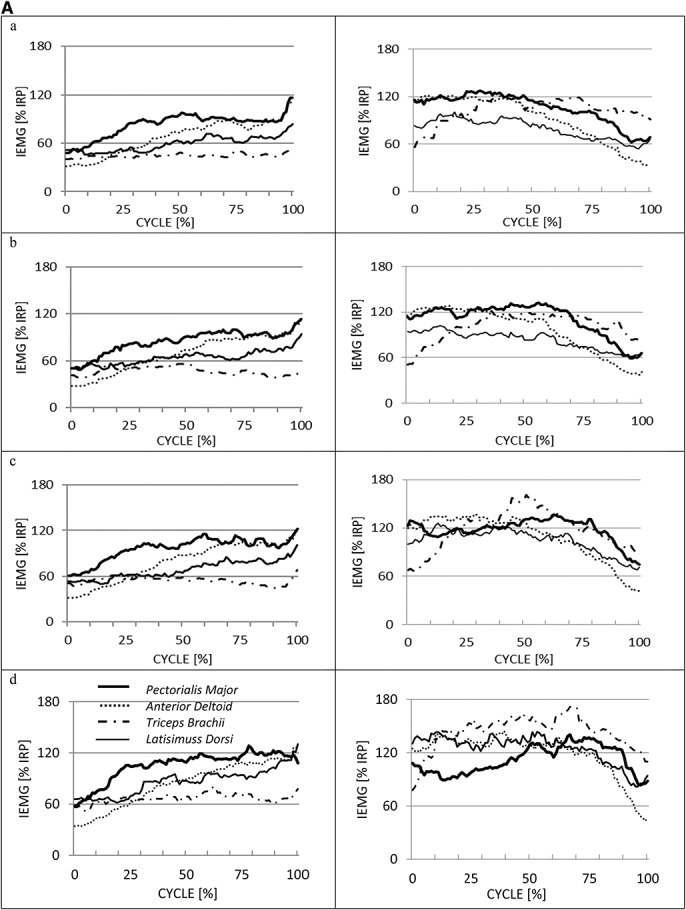
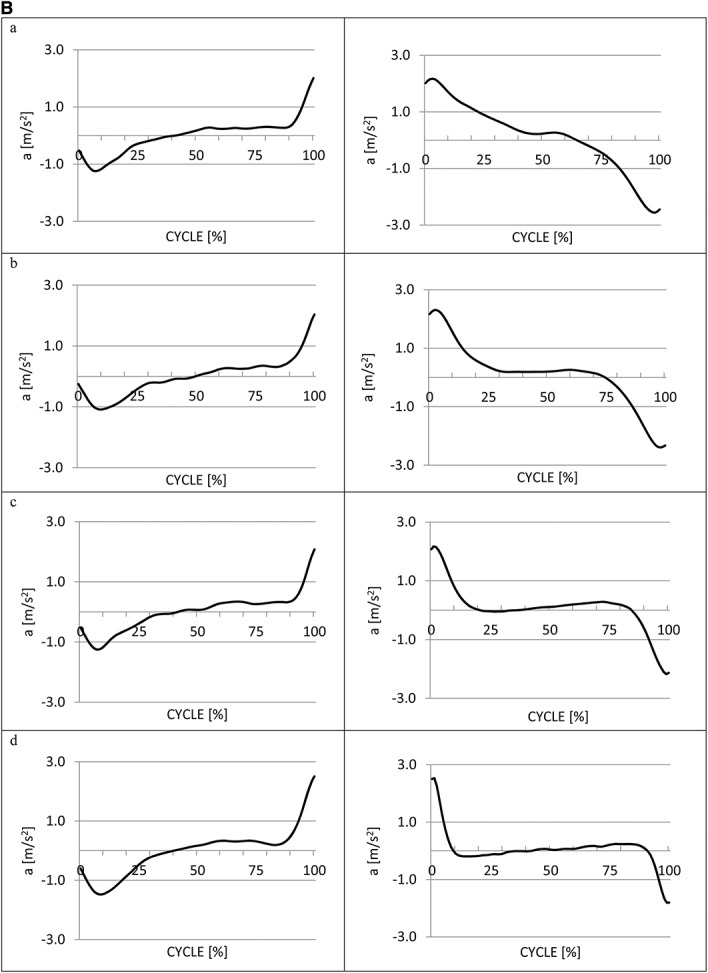
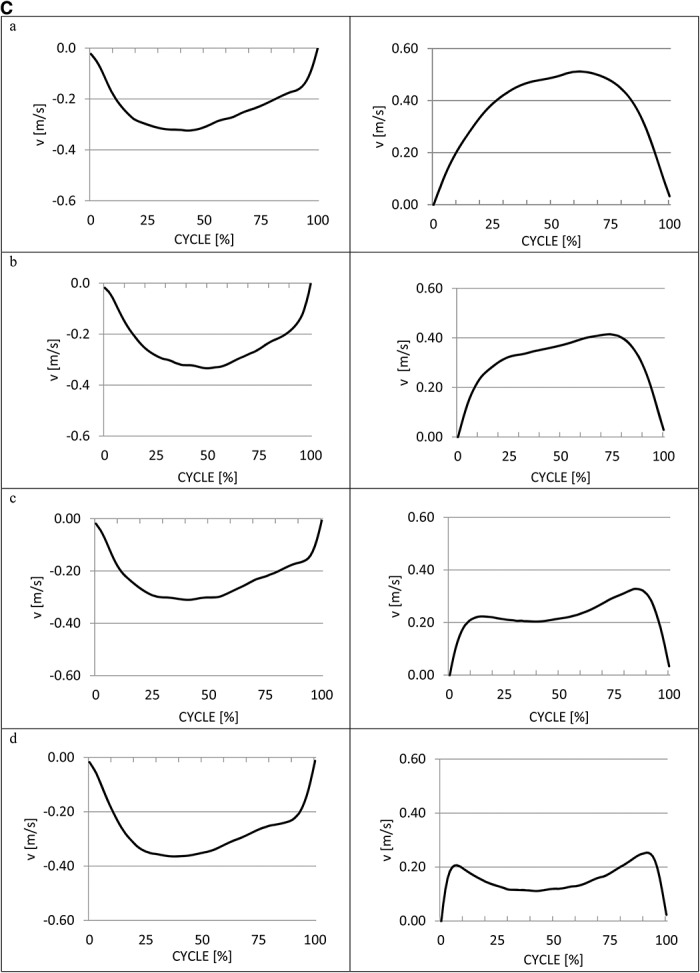
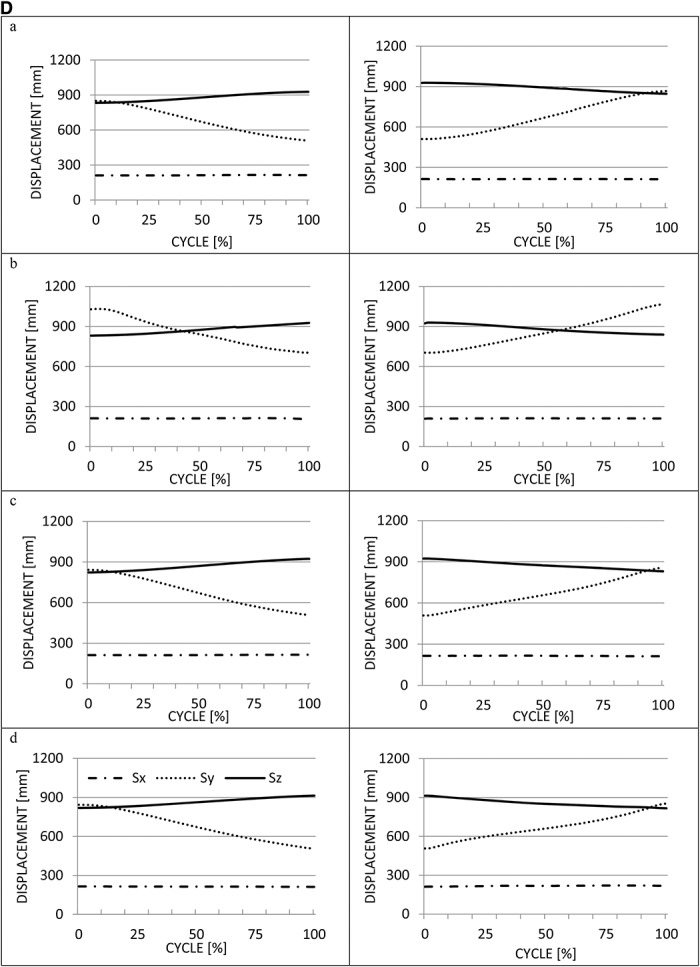
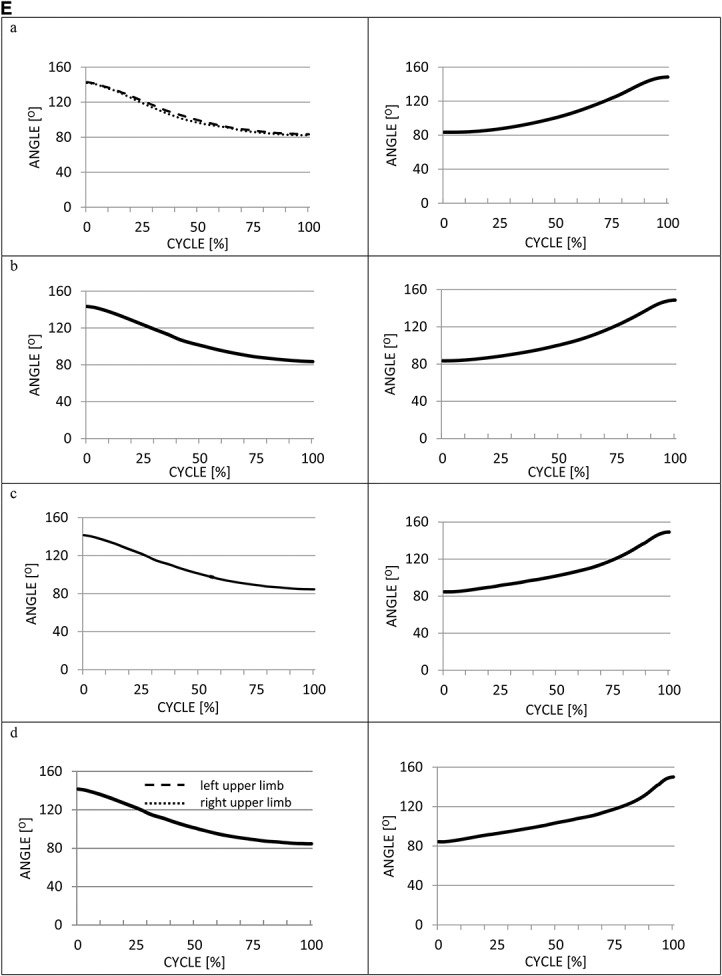
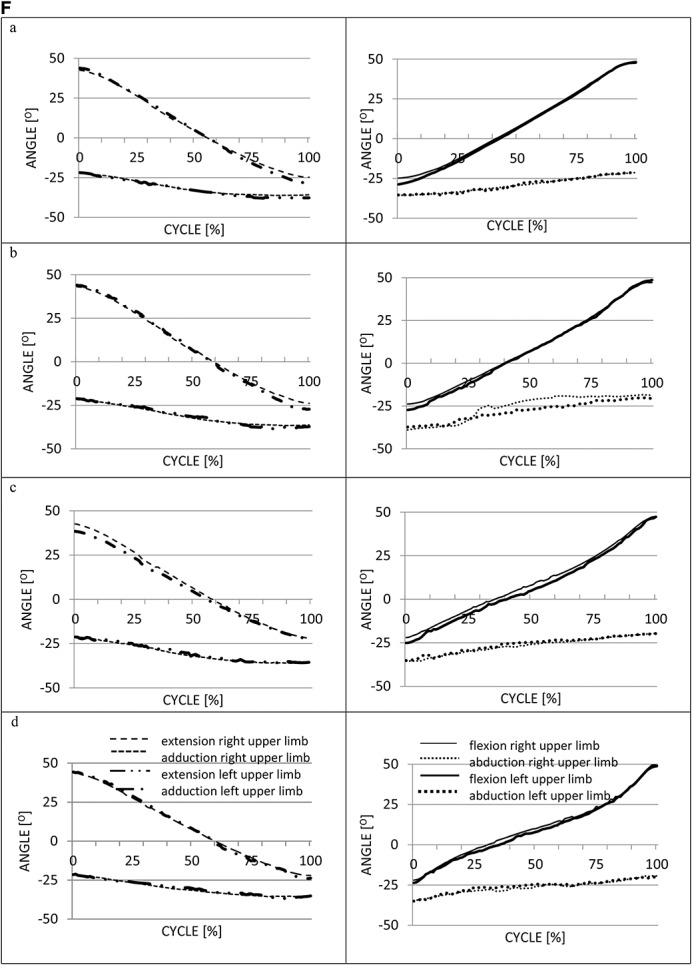
Phase structure of the movement. A) Internal structure (averaged and normalized IEMG of shoulder muscle activity) of the descent phase (left string of figures) and ascent phase (right string of figures) during the flat bench press when attempting loads at: (a) 70% 1RM, (b) 80% 1RM, (c) 90% 1RM, and (d) 100% 1RM. IEMG [% IRP]—IEMG activity as a percentage of the peak activity found during the isometric reference position. B) External structure (the vertical acceleration of the barbell) of the descent phase (left string of figures) and ascent phase (right string of figures) during the flat bench press when attempting loads at: (a) 70% 1RM, (b) 80% 1RM, (c) 90% 1RM, and (d) 100% 1RM. C) External structure (the vertical velocity of the barbell) of the descent phase (left string of figures) and ascent phase (right string of figures) during the flat bench press when attempting loads at: (a) 70% 1RM, (b) 80% 1RM, (c) 90% 1RM, and (d) 100% 1RM. D) External structure (the displacement of the 3 directions: vertical—sy and horizontal—sx—from side to side, sz—from shoulder towards the nipple line, and contrariwise) of the descent phase (left string of figures) and ascent phase (right string of figures) during the flat bench press when attempting loads at: (a) 70% 1RM, (b) 80% 1RM, (c) 90% 1RM, and (d) 100% 1RM. E) External structure (the angle-time curves of the elbow joints in the right and left limbs) of the descent phase (left string of figures) and ascent phase (right string of figures) during the flat bench press when attempting loads at: (a) 70% 1RM, (b) 80% 1RM, (c) 90% 1RM, and (d) 100% 1RM. F) External structure (the angle-time curves of the shoulder joints in the right and left limbs) of the descent phase (left string of figures) and ascent phase (right string of figures) during the flat bench press when attempting loads at: (a) 70% 1RM, (b) 80% 1RM, (c) 90% 1RM, and (d) 100% 1RM.
Table 3.
Integrated and normalized electromyographic muscle activity IEMG (% IRP—isometric reference position) of the: sternocostal head of pectoralis major, anterior deltoid, lateral head of triceps brachii, and latissimus dorsi for the descent phase of the flat bench press with increasing weight of the barbell at selected time points.
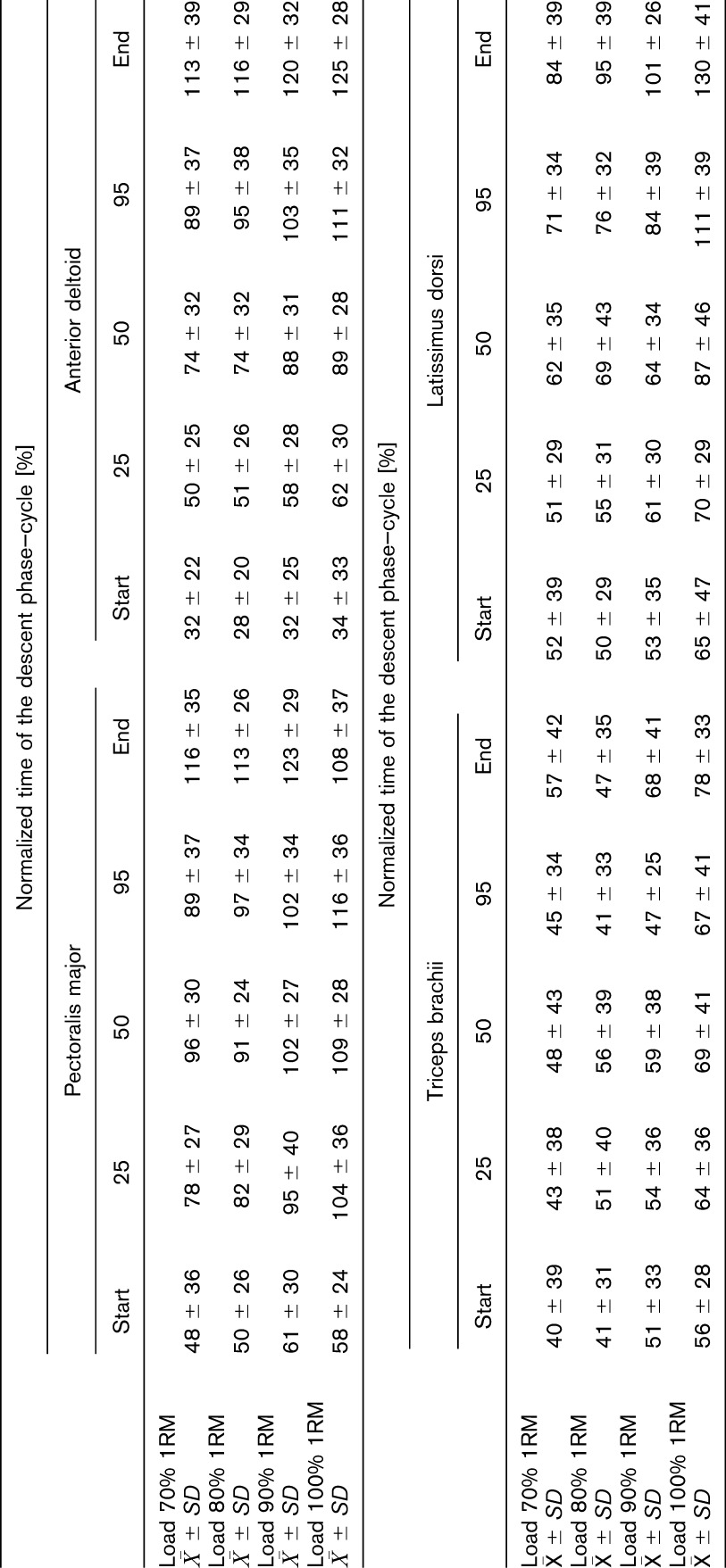
Table 4.
Integrated and normalized electromyographic muscle activity IEMG (% IRP—isometric reference position) of the: sternocostal head of pectoralis major, anterior deltoid, lateral head of triceps brachii, and latissimus dorsi for the ascent phase of the flat bench press with increasing weight of the barbell at selected time points.
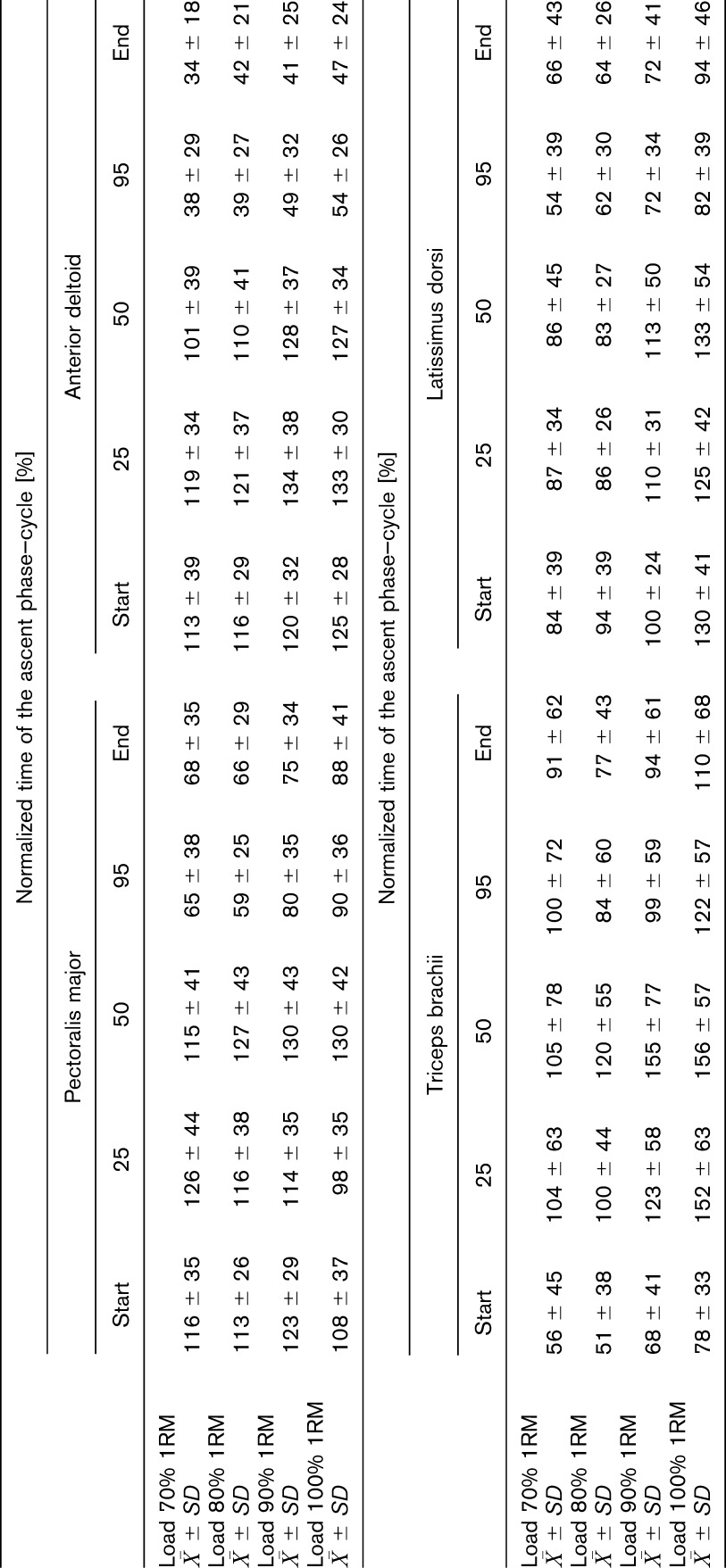
Acceleration of the Barbell
Multivariate ANOVA was conducted to determine changes in the acceleration of the barbell—according to the studied loads (from 70 to 100% of 1RM). The test results showed that the value of the load had a significant effect on mean acceleration (F = 65.43 and p = 0.001) and maximum acceleration (F = 15.94 and p = 0.001) during the ascent phase of bench presses. The Tukey post hoc test showed that the highest values of significance of differences occurred for loads of 70 and 100% of 1RM with respect to the mean acceleration (p = 0.001) and maximum acceleration (p = 0.001) during the ascent phase, and for the loads of 80 and 100% of 1RM with respect to the mean acceleration (p = 0.009) and maximum acceleration (p = 0.019).
Velocity of the Barbell
Multivariate ANOVA was conducted to determine the changes in the velocity of the barbell—according to the studied loads from 70 to 100% of 1RM. The test results showed that the value of the load had a significant effect on mean velocity (F = 128.34 and p = 0.001) and maximum velocity (F = 73.31 and p = 0.001) during the ascent phase of bench presses. The conducted Tukey post hoc test showed the highest values of the significance of differences occurred for loads of 70 and 100% of 1RM with respect to the mean velocity (p = 0.001) and maximum velocity (p = 0.001) during the ascent phase, and for loads of 80 and 100% with respect to the mean velocity (p = 0.012) and maximum velocity (p = 0.021).
Displacement of the Barbell
The horizontal displacement of the barbell—from the shoulder line toward the nipples and contrariwise (sz)—is considerably higher than horizontal displacement from side to side (sx) (Table 5). This was true of both the descent and the ascent phase. The mean horizontal displacement of the barbell (sz) in the ascent phase increases with an increase in the barbell load. In the vertical motion (sy) of the barbell during the bench presses, the displacement values were a few times higher than the horizontal ones. These values ranged between 330 and 342 mm in the descent phase, and between 347 and 361 mm in the ascent phase (Table 5). The time of the descent and ascent phase is shown in Figure 3.
Table 5.
The mean ± SD for displacement of the barbell (millimeter): vertical (sy) and horizontal (sx—from side to side; sz—from the shoulder line towards the nipples and contrariwise) during the ascending and descending phase of the flat bench press when loads were 70, 80, 90, and 100% 1RM.

Figure 3.
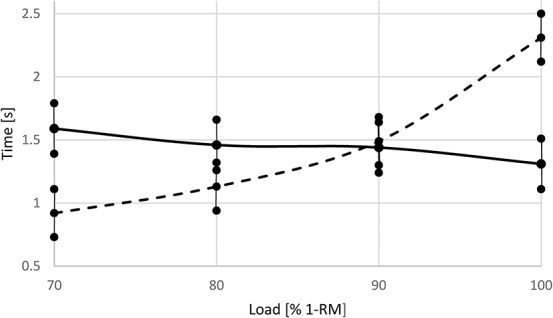
The mean ± SD of the time of the descent (the solid line) and ascent phases (the dashed line) during the flat bench press depending on the weight of the lifted barbell.
Correlation Between Muscle Activity and Displacement of the Barbell
The relationship between the horizontal displacement (sz) of the barbell and the bioelectrical activity of the deltoideus anterior muscle and the latissimus dorsi muscle is worth noting. In both cases, the values of the correlation coefficient r were high and ranged between 0.64 and 0.88 (the deltoideus muscle), and between 0.70 and 0.83 (the latissimus muscle), with all 4 load sizes taken into consideration. In the case of the triceps brachii muscle, a correlation with the horizontal displacement sz of the barbell was not observed. In the case of the pectoralis major muscle, a correlation with horizontal displacement sz of the barbell in bench press attempts with a load of 70 and 80% of 1RM was very strong and positive (r = 0.80), but with a load of 90%, it was very weak (r = 0.30). In attempts with a 100% 1RM load, the correlation was weak but negative (r = −0.49).
Correlation Between Muscle Activity and the Change of the Angle (the Motion Range) of the Joints of the Upper Limbs
The relationship between the changes of the angle in the joints and the bioelectrical activity of the deltoides anterior muscle and the latissimus dorsi muscle is worth noting. In both cases, the values of the correlation coefficient r were high and ranged between −0.63 and −0.99 (the deltoideus muscle), and between −0.63 and −0.96 (the latissimus muscle), taking into consideration all 4 load sizes. As was similar to the correlation between the displacement (sz) of the barbell and muscle activity, the triceps brachii muscle once more showed the weakest correlation (r = –0.20/–0.38). In some cases, no correlation was observed. In the case of the pectoralis major muscle, the correlation with the change of the angle of the upper limb joints in bench press attempts with a load of 70% of 1RM was very strong and negative (r = −0.84/−0.95). This correlation continued to weaken though, as the load increased (from a load of 90% of 1RM, r = −0.56/−0.22). In attempts with a 100% 1RM load, the correlation was very weak and positive (r = 0.12/0.38).
Discussion
The flat bench press is one of the events in competitive powerlifting. It is one of the most popular exercises among athletes and recreational weight trainers. The flat bench press is a popular exercise used for the muscular development of the upper body. Despite the extensive use of this exercise in many exercise regimes, there is a lack of published research directed toward the mechanical understanding of this movement (4). Bearing in mind that biomechanics is concerned with the forces that act on the human body and the effects that these forces cause, the first thing to be considered is the muscle action. Skeletal muscles are the primary actuator of the movement and are a real biological system designed to produce mechanical force and cause movement. The internal structure (the level and duration of bioelectrical muscle activity) of the flat bench press reflects the activity of muscle forces. These muscle forces are the main cause, apart from gravity forces, of the motion of the upper limbs and the barbell.
According to various authors (1,4,21,25), analysis of the internal structure of 4 main shoulder muscles involved in flat bench pressing, indicates that the muscle activity in the descent phase is much less than in the ascent phase. The present findings confirmed these results (Table 2). Generally, persons performing the exercise do not have much difficulty with the descent phase. The task becomes more difficult in the ascent phase. During the ascent phase, the barbell requires a thrust, and, simultaneously, the joints need to be appropriately stabilized to reach the right motion direction of the barbell. Thus, the shoulder muscle activity is not only associated with barbell lifting. A certain part of the muscle activity is needed to balance and stabilize the barbell during free weight lifts. Co-activation of the shoulder muscles is also necessary in weight displacement control. On the other hand, it has been reported that the prime movers play an insignificant role in barbell stabilization during free weight lifts (22). Lander et al. (17) suggested that the lifter must devote force so as to balance and stabilize the bar in 2 horizontal directions, during a free-weight bench press. This is evidenced by the results obtained by McCaw and Friday (21) who found that greater muscular activity was present during a free-weight shoulder press compared with during a machine press. Overall, our results indicate that muscle activity increased significantly in the pectoralis major, deltoideus anterior, triceps brachii, and latissimus dorsi muscles as resistance exercise intensity increased from 70 to 100% 1RM. The exception is the pectoralis major muscle which at the beginning of the ascent phase with a 100% 1RM loading, showed decreased activity (Figure 2A). However, less pectoralis major muscle activity is accompanied by a greater triceps brachii activity. This means the role of the pectoralis major muscle changes from a prime mover to a supportive-prime mover. For all subjects, the anterior deltoid and the pectoralis major electrical activity, irrespective of the barbell weight, already showed greater activity at the beginning of the ascent phase and persisted for almost the entire time of the duration of this phase. The exception was that there was less pectoralis activity at the beginning of this phase at a 100% 1RM load. In the case of the triceps brachii, the muscle activity increased at the very beginning of the ascent phase. Further increase occurred later in this phase. Based on the current IEMG results, it seems that the barbell weight determined an individual's performance on the flat bench press.
Barbell kinematics express the muscle involvement in the bench press. Barbell kinematics are characterized, inter alia, by the graph of acceleration (Figure 2B). The vertical acceleration-time curve of the barbell definitely changes when the weight of loading increases. In the flat bench pressing ascent-phase, for the 70 and 80% 1RM conditions, the graph has one positive acceleration area (region) and one negative acceleration area (Figure 2B; right string of figures; 2 top curves). In the attempts for the 90 and 100% 1RM conditions, there are already 2 acceleration regions and 2 deceleration regions (Figure 2B; right string of figures; 2 bottom curves). When there are 4 specific areas, the areas are named: the acceleration phase, the sticking region, the maximum strength region, and the deceleration phase (4,17). The number of these areas increases as the weight load increases. The more areas an acceleration-time curve has, though, the less smooth is the movement. This is because the number of the changes that the acceleration direction (number of +/−) has, is a measure of the fluidity of the movement (14,27). Therefore, when the movement is not smooth, it means the sport technique is worse, and the chronological coordination of individual impulses is incorrect (11). This is referred to as “the principle of the chronological coordination of individual impulses.”
Based on the number of the acceleration areas, the technique differences of a powerlifter and bodybuilder can be seen (12,13). It is related to the activity of the individual muscles of the shoulder girdle. Both the powerlifter and bodybuilder are characterized by an increased IEMG activity of the triceps brachii if the load increases. However, only in the case of the powerlifter does this increase take place at the end of the descent phase. In the case of the bodybuilder, the increase takes place at the beginning of the ascent phase. Similar differences are seen in the pectoralis major and anterior deltoideus. The differences in the sequences of muscle activation during the bench press was pointed out by Van den Tillaar and Ettema (29). In their opinion, “only in the pectoralis and front portion of your deltoideus muscle do you experience significant contractions during the upward movement (the ascent phase) of the barbell.” On the other hand, they also state that, “as you blast the barbell off your chest, there is actually peak muscle output coming from your triceps.” Therefore, for an effective improvement of a technique, trainers are required to use an individual approach with each athlete. Such a requirement is significantly difficult because the internal structure of movement and the acceleration-time curve are not observable (14,26).
Acceleration characteristics are reflected in the velocity curve. Generally, the vertical component of a barbell velocity (the average and the maximum values) decreases together with increased loading. (Figure 2C; right string of figures). As the load is increased, the time of the descent phase and ascent phase changed (Figure 3), so the rhythm of the flat bench press (The rhythm of the movement—the temporal relations of the characteristic phases or cycles of the motor activity, determined on the basis of the kinematic and kinetic structure (14).) also changed. In the flat bench pressing ascent-phase, at a load of 70 and 80% 1RM, the velocity reached one maximum, and in attempts at 90 and 100% 1RM, there were 2 maximum and one minimum velocities. This decrease in the barbell velocity is called the sticking region (3,20,29). Each study on the bench press has identified a sticking point or sticking region (period) at a relatively constant position in the movement, where the lifter experienced apparent difficulty in exerting force against the barbell (4). According to Van den Tillaar and Ettema (29) it is only clearly visible at loads ≥90%, and the sticking region is caused not by a lack of muscle strength per se, but the delay in switching from the maximal triceps contraction to the maximal pectoralis and deltoideus contraction.
Further external-kinematic structure of the flat bench press is shown in Figure 2D. This structure include the values of the displacement of the barbell in 3 directions (3D), depending on the magnitude of the load (Table 5). The barbell path during the ascent phase differed between the load conditions. The horizontal displacement of the barbell; from the shoulder line towards the nipples line and contrariwise (sz), was especially distinct. The total horizontal path (sz) in the increased load attempts, was on average: at 70% 1RM—86 ± 36 mm, at 80% 1RM—98 ± 35 mm, at 90% 1RM—101 ± 37 mm, and at 100% 1RM up till 123 ± 38 mm. The difference of the horizontal displacement (sz) in the attempts at the 70 and 100% loads was statistically significant (p = 0.0004). In the study by Elliott et al. (4), when 10 male elite bench-pressers lifted the barbell at an 81% load, the horizontal displacement of the barbell was about 90 mm, and when the barbell was lifted at a 100% load, the horizontal displacement was about 130 mm. So, again, the greatest range in the changes of this barbell horizontal displacement was found in the attempts at the maximum load. According to Elliott et al. (4), as the load increased, and thus the need to reduce the moment arm about the shoulder axis (sagittal plane) became increasingly important, there was a trend toward an increased horizontal displacement of the barbell toward the shoulder during the ascent phase. Why is the lowered barbell not directed in the vicinity of the shoulders, but instead moves to the lower portion of the pectorals (towards the nipple line)? The answer is, probably for health reasons. According to Green and Comfort (8), the flat bench press should be performed with a grip <1.5 times the biacromial width, lowering the barbell to the lower portion of the pectoralis to reduce the level of abduction and external rotation at the shoulder. If the level of abduction at the shoulder is considerably less than a right angle and there is minor external rotation at the shoulder, it seems that it would be possible to reduce the risk of acute and chronic shoulder injuries. Anterior glenohumeral instability is considered a chronic condition that may occur in individuals who regularly perform weight-training exercises with the shoulder approaching a 90° abduction, and may be increased with external rotation (9).
In summary, individuals who undergo strength training often use a different magnitude of weightlifting loads; from moderate intensity to submaximal and maximal. The result is a change in the structure of the exercise movements (12–14). A coach's ability to direct technical and physical training for the bench press is enhanced when thorough descriptions of this skill (the characteristics of the movement) are available. The change in the structure of the movement is best seen at an individual approach to each lift. In this study, the changes concerned both the internal structure (muscle activity) and external structure (displacement and velocity and acceleration-time curves of the barbell) of the bench press. Particularly surprising is the pectoralis major muscle activity in the attempts at a 100% 1RM load. A smaller activity of the pectoralis muscle at the beginning of the ascent phase during the bench press means a change of role for this muscle from the prime mover to the supportive-prime mover. Further research is still needed that focuses on muscle activity in the prime movers and stabilizing muscles of the representatives of various disciplines utilizing strength exercises (powerlifters, bodybuilders) during the bench press at the different loads.
Practical Applications
The co-activation of the shoulder muscles during the flat bench press is necessary mainly to displace the weight of the barbell. However, a certain part of the muscle activity is also needed to balance and stabilize the barbell during free weight lifts (17,21,22). During the flat bench press done while the load is increased, the role of the involved muscles is sometimes reversed. The pectoralis major during the flat bench press at a 100% 1RM load, changes from that of the prime mover to that of a supportive prime-mover. At this time, the role of the prime mover is taken on by the deltoideus anterior and the triceps brachii which shows its greatest involvement.
During the ascent phase of the flat bench press at very high exercise intensities (i.e., ≥90% 1RM), a deceleration region (sticking period) occurs in which the vertical velocity of the barbell decreases (3,4,20,29). The rapid reduction of the moment arm about the shoulder axis can overcome or decrease the apparent difficulty by exerting force against the barbell and moving through the sticking region (4).
The reason for the occurrence of the sticking period is the vertical acceleration-time curve of the barbell which definitely changes when the weight of loading increases (3,4,20). The result of this is the number of the positive and negative acceleration areas. The more areas an acceleration-time curve has, though, the less smooth is the movement. This is because the number of the changes that the acceleration direction (number of +/−) has, is a measure of the fluidity of the movement (14,27).
It has been suggested that the descent phase of the flat bench press should finish at the nipple level, and the grip width should be <1.5 times the biacromial width (8). The reduction of the grip width and a descent of the barbell to the nipple area should decrease the angle of abduction and possible external rotation at the shoulder. In turn, these movements should potentially reduce the risk of shoulder injury without altering the benefits or performance of the exercise.
As we and others have previously recommended, the use of heavier loads during resistance training programs to stimulate the maximal development of strength and hypertrophy is further supported.
Acknowledgments
This study was made possible by the financial support of the Ministry of Science and Higher Education of Poland and the Jerzy Kukuczka Academy of Physical Education in Katowice. The authors would like to thank Dr. Adam Maszczyk for his work during data analysis/statistics.
References
- 1.Anderson KG, Behm DG. Maintenance of EMG activity and loss of force output with instability. J Strength Cond Res 18: 637–640, 2004. [DOI] [PubMed] [Google Scholar]
- 2.Drinkwater EJ, Galana B, McKenna MJ, Hunt PH, Pyne DB. Validation of an optical encoder during free weight resistance movements and analysis of bench press sticking point power during fatigue. J Strength Cond Res 21: 510–517, 2007. [DOI] [PubMed] [Google Scholar]
- 3.Duffey MJ, Challis JH. Fatigue effects on bar kinematics during the bench press. J Strength Cond Res 21: 557–560, 2007. [DOI] [PubMed] [Google Scholar]
- 4.Elliott BC, Wilson GJ, Kerr GK. A biomechanical analysis of the sticking region in the bench press. Med Sci Sports Exerc 21: 450–462, 1989. [PubMed] [Google Scholar]
- 5.Ferreira SL, Panissa VL, Miarka B, Franchini E. Postactivation potentiation: Effect of various recovery intervals on bench press power performance. J Strength Cond Res 26: 739–744, 2012. [DOI] [PubMed] [Google Scholar]
- 6.Floyd L, Otte A, Meyhew JL. Comparison of 1-RM bench press performance between free weights and machine weights. Mo J Health Phys Educ Recreation Dance 19: 95–103, 2009. [Google Scholar]
- 7.Garcia-Lopez D, Izquierdo M, Rodriguez S, Gonzalez-Calvo G, Sainz N, Abadia O, Herrero AJ. Interset stretching does not influence the kinematic profile of consecutive bench-press sets. J Strength Cond Res 24: 1361–1368, 2010. [DOI] [PubMed] [Google Scholar]
- 8.Green CM, Comfort P. The affect of grip width on bench press performance and risk of injury. Strength Cond J 29: 10–14, 2007. [Google Scholar]
- 9.Gross ML, Brenner SL, Esformers I, Sonzgoni JJ. Anterior shoulder instability in weight lifters. Am J Sports Med 21: 599–603, 1993. [DOI] [PubMed] [Google Scholar]
- 10.Hermens HJ, Freriks B, Merletti R, Stegeman D, Blok J, Rau G. European Recommendations for Surface Electromyography: Results of the SENIAM Project. Enchede, NL: Roessing Research and Development, 1999. [Google Scholar]
- 11.Hochmuth G. The Biomechanics of Sportive Movements. Berlin, Germany: Sportverlag, 1981. [Google Scholar]
- 12.Król H, Garbaciak B. The movement features which describe the flat bench press. Pol J Sport Tourism, 2017. In press. 2017. [Google Scholar]
- 13.Król H, Kmiecik K. Kinematics of the barbell during the flat bench press in a bodybuilder and a powerlifter. In: Słomka KJ, Juras G, eds. Current Research in Motor Control, V. Bridging Motor Control and Biomechanics. Katowice, Poland: The Jerzy Kukuczka Academy of Physical Education in Katowice, 2016. pp: 136–148. [Google Scholar]
- 14.Król H, Mynarski W. The Movement Features—Characteristic and Possibilities of Parametrization. Katowice, Poland: Academy of Physical Education in Katowice, 2005. [Google Scholar]
- 15.Król H, Golas A, Sobota G. Complex analysis of movement in evaluation of flat bench press performance. Acta Bioeng Biomech 12: 93–98, 2010. [PubMed] [Google Scholar]
- 16.Lagally KM, McCaw ST, Young GT, Medema HC, Thomas DQ. Ratings of perceived exertion and muscle activity during the bench press exercise in recreational and novice lifters. J Strength Cond Res 18: 359–364, 2004. [DOI] [PubMed] [Google Scholar]
- 17.Lander JE, Bates BT, Sawhill JA, Hammill J. A comparison between free-weight and isokinetic bench pressing. Med Sci Sports Exerc 17: 344–353, 1985. [PubMed] [Google Scholar]
- 18.Lehman GJ. The influence of grip width and forearm pronation/supination on upper-body myoelectric activity during the flat bench press. J Strength Cond Res 19: 587–591, 2005. [DOI] [PubMed] [Google Scholar]
- 19.Looney DP, Kraemer WJ, Joseph MF, Comstock BA, Denegar CR, Flanagan SD, Newton RU, Szivak TK, DuPont WH, Hooper DR, Häkkinen K, Maresh CM. Electromyographical and perceptual responses to different resistance intensities in a squat protocol: Does performing sets to failure with light loads produce the same activity? J Strength Cond Res 30: 792–799, 2016. [DOI] [PubMed] [Google Scholar]
- 20.Madsen N, McLaughlin T. Kinematic factors influencing performance and injury risk in the bench press exercise. Med Sci Sports Exerc 16: 376–381, 1984. [PubMed] [Google Scholar]
- 21.McCaw ST, Friday JJ. A comparison of muscle activity between a free weight and machine bench press. J Strength Cond Res 8: 259–264, 1994. [Google Scholar]
- 22.Norwood JT, Anderson GS, Gaetz MB, Twist PW. Electromyographic activity of the trunk stabilizers during stable and unstable bench press. J Strength Cond Res 21: 343–347, 2007. [DOI] [PubMed] [Google Scholar]
- 23.Pearson SN, Cronin JB, Hume PA, Slyfield D. Kinematics and kinetics of the bench-press and bench-pull exercises in a strength-trained sporting population. Sports Biomech 8: 245–254, 2009. [DOI] [PubMed] [Google Scholar]
- 24.Rahmani A, Rambaud O, Bourdin M, Mariot JP. A virtual model of the bench press exercise. J Biomech 42: 1610–1615, 2009. [DOI] [PubMed] [Google Scholar]
- 25.Santana JC, Vera-Garcia FJ, McGill SM. A kinetic and electromyographic comparison of the standing cable press and bench press. J Strength Cond Res 21: 1271–1279, 2007. [DOI] [PubMed] [Google Scholar]
- 26.Schnabel G. General movement characteristics as an expression of the movement coordination. In: Meinel K, Schnabel G, eds. Teaching of Movement—Sport Motorics (12th ed.). Berlin, Germany: Volk u. Wissen Volkseigener Verlag, 1998. pp: 90–170. [Google Scholar]
- 27.Schneider K. The Acceleration Effort Than Quantitative Description of the Motion Flow. Sportwissenschaft 2. Schorndorf, Germany: Hofmann, 1990. pp: 192–199. [Google Scholar]
- 28.Uchida MC, Nosaka K, Ugrinowitsch C, Yamashita A, Martins E, Jr, Moriscot AS, Aoki MS. Effect of bench press exercise intensity on muscle soreness and inflammatory mediators. J Sports Sci 27: 499–507, 2009. [DOI] [PubMed] [Google Scholar]
- 29.Van den Tillaar R, Ettema G. A comparison of successful and unsuccessful attempts in maximal bench pressing. Med Sci Sports Exerc 41: 2056–2063, 2009. [DOI] [PubMed] [Google Scholar]


